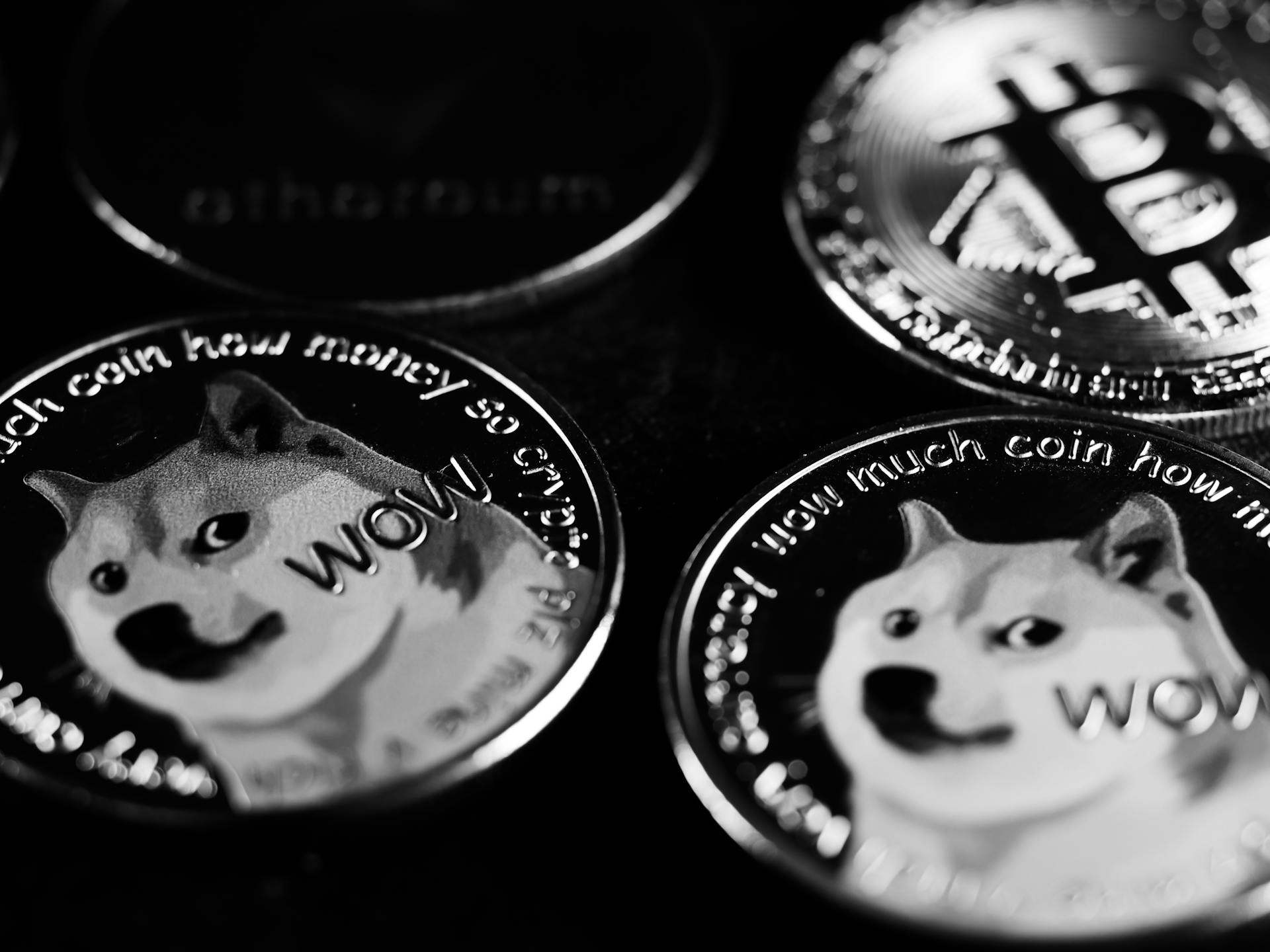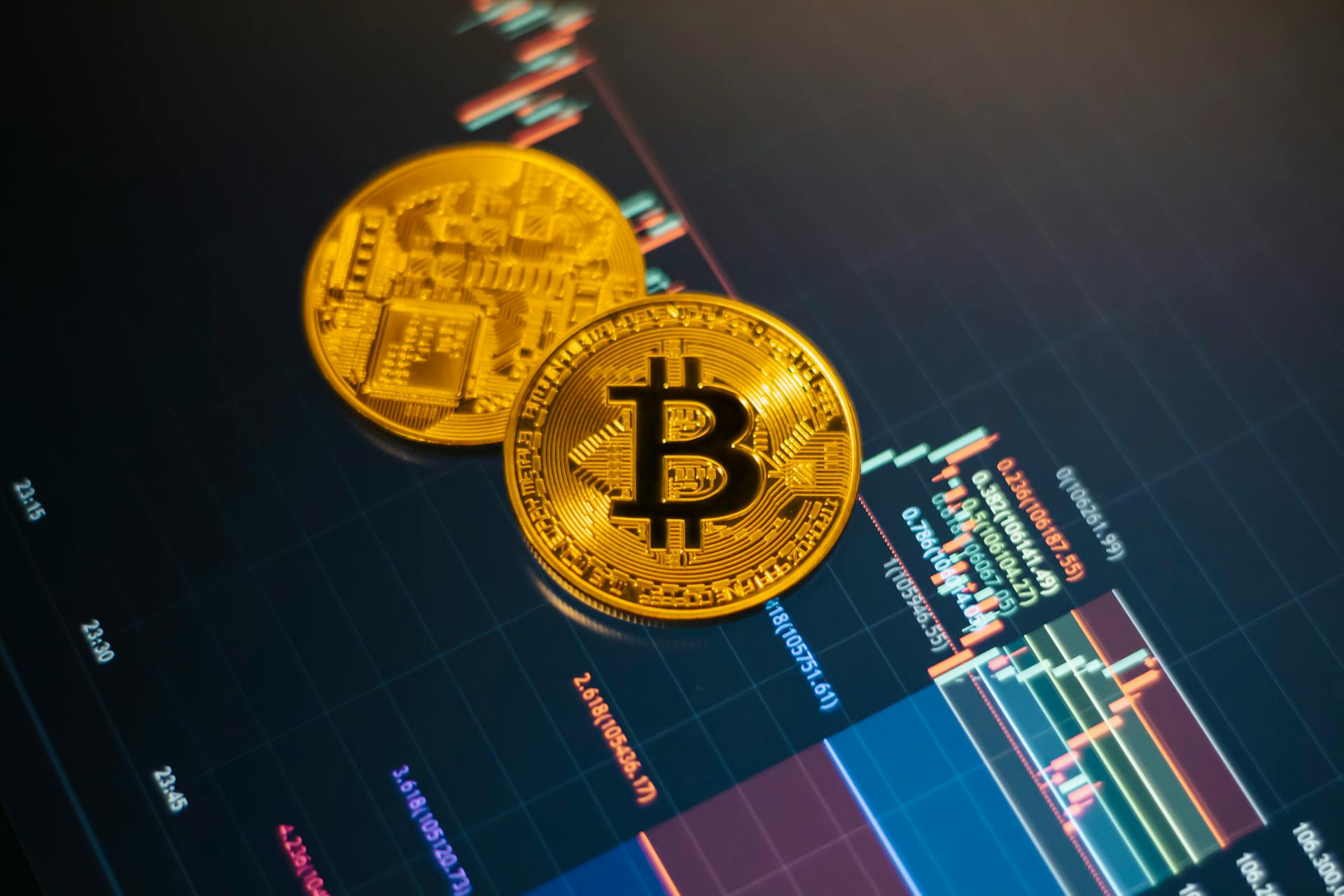
Altcoin is a type of cryptocurrency that is alternative to Bitcoin. It's created on a different blockchain and has its own unique features and uses.
Altcoins can be created using various programming languages, such as C++ or Java, and are often developed by individuals or teams with a specific vision or goal in mind.
The first altcoin was Namecoin, which was launched in 2011. It was created as a decentralized domain name system to provide a secure and censorship-resistant way to register domain names.
Altcoins can have different consensus algorithms, such as Proof of Stake (PoS) or Delegated Proof of Stake (DPoS), which can affect their energy consumption and transaction speed.
Types of Altcoins
Altcoins can be categorized into different types based on their purpose and functionality. Some altcoins are designed to maintain a stable value by pegging their price to a fiat currency or a commodity, known as stablecoins.
There are also altcoins that provide access to specific products or services within a blockchain ecosystem, called utility tokens. These tokens can be used for functionalities such as voting rights, access to decentralized applications, or obtaining discounts on platform fees.
Here are some of the main types of altcoins:
Bitcoin Forks and Derivatives
Bitcoin forks are essentially new cryptocurrencies created from the existing Bitcoin code.
Some notable Bitcoin forks include Litecoin, which has a fixed supply and needs to be mined through Proof-of-Work.
Litecoin is one of the most well-known Bitcoin forks, but it's not the first. Namecoin was the very first altcoin to be forked from Bitcoin, introduced in April 2011.
Namecoin was based on Bitcoin's source code and is also limited to 21,000,000 coins, just like Bitcoin.
Mining-Based Coins
Mining-based coins use a process called mining to verify transactions and add more coins to the supply. This process requires significant energy.
Miners use devices to solve mathematical equations, with the first miner to solve the equation getting to verify a block of transactions. In return, miners receive crypto rewards.
Examples of mining-based coins include Litecoin (LTC), Ethereum Classic (ETC), and Dogecoin (DOGE). These coins have a fixed supply and need to be mined through a process called Proof-of-Work.
Expand your knowledge: Virtual Coins
The PoW consensus mechanism drives competition for faster and more powerful computational processing power. This has led to the development of advanced computers that require a substantial amount of costly and extremely environmentally damaging energy.
Namecoin, the first altcoin to be forked from Bitcoin, is also a mining-based coin. It was introduced in April 2011 and is limited to 21,000,000 coins like Bitcoin.
Staking-Based Coins
Staking-based coins are a type of altcoin that uses a proof-of-stake (PoS) consensus mechanism, making them more energy-efficient and environmentally friendly than coins mined using a proof-of-work (PoW) mechanism.
These coins require investors to hold funds in a cryptocurrency wallet in exchange for rewards over time, and the network uses them to forge new blocks on the blockchain.
Examples of stake-based coins include Cardano (ADA) and Solana (SOL), which have gained popularity due to their energy efficiency and affordability.
Staking is a process that verifies transactions and adds more coins to the supply, allowing holders to pledge their coins for transaction processing and receive crypto rewards.
Peercoin (CRYPTO:PPC) was the first altcoin to introduce staking, and although it hasn't become a household name, staking has become popular due to its energy efficiency compared to mining.
Staking-based coins are more environmentally friendly and affordable than coins mined using a PoW mechanism, making them an attractive option for investors.
Key Differences from Bitcoin
Altcoins differ from Bitcoin in several key ways. Altcoins are created on separate blockchains from Bitcoin, and their primary objective is not always to be a store of value and a medium of exchange.
Altcoins use various technologies and processes, including proof-of-stake or proof-of-work consensus mechanisms, enhanced privacy features, reduced fees, and faster transaction speeds. This is a significant departure from Bitcoin's technology.
The term 'altcoin' applies to any cryptocurrency other than Bitcoin, and altcoins have varying supply, demand, market caps, and liquidity. Some altcoins have a similar objective to Bitcoin, but many coins and tokens have more specific use cases. For example, governance tokens provide participants with voting power on blockchain projects.
Here are the key differences between altcoins and Bitcoin:
- Purpose: Bitcoin's primary objective is to be a store of value and a medium of exchange, while altcoins have more specific use cases.
- Technology: Altcoins use various technologies and processes, such as proof-of-stake or proof-of-work consensus mechanisms, enhanced privacy features, reduced fees, and faster transaction speeds.
- Market capitalization: Altcoins have varying supply, demand, market caps, and liquidity.
Bitcoin Key Differences
Bitcoin's primary objective is to be a store of value and a medium of exchange. This is a key difference from many altcoins, which have more specific use cases.
Altcoins use many different technologies and processes than Bitcoin, including proof-of-stake or proof-of-work consensus mechanisms. This is a significant departure from Bitcoin's traditional proof-of-work model.
Some altcoins provide participants with voting power on blockchain projects, giving them a governance role. This is a notable difference from Bitcoin, which doesn't have a similar governance system.
Altcoins have varying supply, demand, market caps, and liquidity, which can make them more unpredictable than Bitcoin.
You might like: How Does Bit Coin Work
Comparing to Bitcoin
Altcoins have a few key differences from Bitcoin. Altcoins are the "better mousetrap" to Bitcoin, meaning they exist on upgraded versions of their former blockchain networks, answering software bugs, inefficiencies, and vulnerabilities previously unresolved.
Altcoins provide more utility and have a better chance at survival in the long run due to their versatility. Their ability to perform different functions in the crypto economy provides adaptability unmatched by Bitcoin, better preparing them for future developments in the market.
Altcoins are considered a riskier investment, despite relative resilience to price fluctuation. They suffer from thin liquidity, high market saturation, a smaller market cap, a lack of credibility, and susceptibility to scams.
Altcoins have notable key differences from Bitcoin, including purpose, technology, and market capitalization. Some altcoins have a specific use case, while others provide voting power on blockchain projects.
Here are some key differences between altcoins and Bitcoin:
- Purpose: Bitcoin's primary objective is to be a store of value and a medium of exchange, while many altcoins have more specific use cases.
- Technology: Altcoins use different technologies and processes than Bitcoin, including proof-of-stake or proof-of-work consensus mechanisms, enhanced privacy features, reduced fees, and faster transaction speeds.
- Market capitalization: Altcoins have varying supply, demand, market caps, and liquidity.
Altcoins are more advanced than Bitcoin, having improved on its technology. Many altcoins offer faster transaction speeds and lower costs than Bitcoin.
Altcoin Characteristics
Altcoins share a common feature with Bitcoin: they can be used for payments on various platforms, not just their native environment. Many altcoins offer unique features like different distribution methods or mining algorithms.
Altcoins are created on separate blockchains from Bitcoin, making them distinct from the original cryptocurrency. Some altcoins are similar to Bitcoin, but they all have their own unique characteristics.
Most altcoins function as a store of value and for handling decentralized peer-to-peer payments, with some offering higher transaction speeds or more privacy.
What Do All Coins Have in Common?
Most altcoins share a common feature: they can be used for payments on various platforms beyond their native environment. This means you can use them for transactions that aren't limited to their own ecosystem.
Many altcoins are actually quite similar to Bitcoin, with only a few unique features like different distribution methods or mining algorithms. Some altcoins offer higher transaction speeds or more privacy than other coins.
They all serve as cryptocurrencies with the main purpose of being a store of value and handling decentralised peer-to-peer payments. This is the core function of most altcoins, regardless of their specific features or use cases.
Some altcoins have been developed for very narrowly defined use cases, but they all diverge from Bitcoin's original purpose as a peer-to-peer payment network.
Governance Tokens
Governance tokens give token holders voting rights on decisions affecting a blockchain project and protocols, such as adding new features or changing rules.
These tokens aim to ensure a fair distribution of power over the network's future, rather than relying on a centralized authority.
Governance tokens also encourage investors to be active participants and facilitate long-term engagement.
Examples of governance tokens include Uniswap (UNI), Maker (MKR), and Aave (AAVE).
Governance tokens are cryptocurrencies that give holders voting rights to help shape the project's future.
This helps make the cryptocurrency a decentralized project since all holders have a say, and decisions aren't made by one central authority.
In most cases, these tokens allow you to create and vote on proposals related to the cryptocurrency.
On a similar theme: Is Bitcoin the Same as Cryptocurrency
Existence Purpose
Altcoins emerged as an attempt to reinvent Bitcoin and improve upon its existing code and trading technology.
The first altcoin, Namecoin, was released in April 2011 and is based on Bitcoin's code. It's designed to be a decentralized domain name system (DNS) to improve the system for establishing ownership of domain names on the web with blockchain technology.
Altcoins aim to improve Bitcoin's flaws and limitations, directly impacting the coin's market potential and function. This is why it's essential to consider altcoins with well-defined purposes and strong use cases.
Namecoin is integral to the history of altcoins, showing there's enough room in the crypto markets for more than one kind of coin. Today, blockchains can run hundreds of "altcoins", fueling similar currency projects with unique rules and mechanisms.
Examples of Altcoins
Altcoins have been around since the early days of cryptocurrency. Namecoin, released in April 2011, is considered the first notable altcoin, based on Bitcoin's code and with a maximum supply of 21 million coins.
Namecoin introduced the concept of .bit web domains, which offer anonymity and resistance to censorship. This was a significant innovation in the crypto space.
Some top altcoins include Ethereum, released in July 2015, which offered a programmable blockchain for developers to use, and USD Coin, released in September 2018, a stablecoin pegged to the U.S. dollar.
Here are some top altcoins to know:
- Ethereum (ETH)
- Tether (USDT)
- Binance (BNB)
- Solana (SOL)
- USD Coin (USDC)
- XRP (XRP)
- Dogecoin (DOGE)
- Toncoin (TON)
- Cardano (ADA)
- Shiba Inu (SHIB)
Example of Altcoin
Altcoins are a fascinating aspect of the cryptocurrency world. There are thousands of them on the market, with some of the most popular options being Litecoin, Ethereum, Dogecoin, and Polkadot.
One of the earliest notable altcoins is Namecoin, released in April 2011. It's similar to Bitcoin since it's based on Bitcoin's code and has the same maximum supply of 21 million coins.
Many altcoins offer unique features that differentiate them from Bitcoin. Some examples include different distribution methods, different mining algorithms, or even the ability to offer higher transaction speeds or more privacy.
Let's take a look at some top altcoins to know:
- Ethereum (ETH)
- Tether (USDT)
- Binance (BNB)
- Solana (SOL)
- USD Coin (USDC)
- XRP (XRP)
- Dogecoin (DOGE)
- Toncoin (TON)
- Cardano (ADA)
- Shiba Inu (SHIB)
Solana, for example, is a third-generation cryptocurrency that leverages a unique hybrid consensus mechanism. It prioritizes expedited exchange and scalability, but also has its drawbacks, such as relative risk to security and criticism of unfair tokenomics.
Litecoin
Litecoin is an altcoin that was created to become the "silver" to Bitcoin's "gold". It's a lighter, faster version of its predecessor, built for speed with a block time four times faster than Bitcoin.
The Litecoin network takes about 2.5 minutes to confirm a transaction, which is significantly faster than Bitcoin's 10-minute average. This makes it a more efficient option for users who need quick transactions.
Litecoin uses a cryptographic algorithm called Scrypt, which is fundamentally different from Bitcoin's algorithm. This difference makes it easier for the average user to mine Litecoin.
Charlie Lee, an early crypto adopter and computer scientist, created Litecoin two years after Bitcoin's genesis block debut. This makes Litecoin one of the first altcoins to enter the market.
Litecoin had originally set out to make access to mining easier for the average user.
Dogecoin - The Fun Crypto
Dogecoin is often considered the fun cryptocurrency, created as a joke in 2013 using a popular internet meme.
It was conceived by software engineers Billy Markus and Jackson Palmer, who forked it from Litecoin, a Bitcoin counterpart.
Dogecoin features Kabosu, a Japanese Shibu Inu, as its mascot, which has become a beloved symbol of the crypto world.
As of August 2019, Dogecoin had a market cap of around US Dollars 298,770,000, showing its surprising rise to popularity.
It's also known as the internet tipping currency, where users give Dogecoin tips to other users for providing interesting content on social media.
Mainstream commercial uses of Dogecoin are limited, but its popularity endures thanks to its fun and lighthearted nature.
Dogecoin has even been endorsed by celebrities like Snoop Dogg, Gene Simmons, and Mark Cuban, further cementing its status as a beloved mascot in the crypto world.
Frequently Asked Questions
What are the top 3 altcoins?
The top 3 altcoins to consider are Solana, Polkadot, and Hyperliquid, each leveraging innovative technologies for potential gains. These altcoins offer strong market potential and unique opportunities for investors.
Is dogecoin an alt coin?
Yes, Dogecoin is an altcoin, also known as an alternative cryptocurrency, with a large and active userbase.
Featured Images: pexels.com


